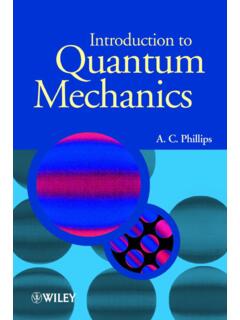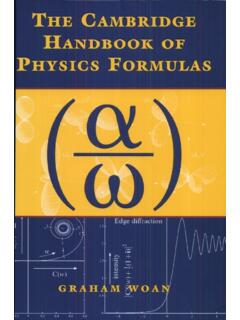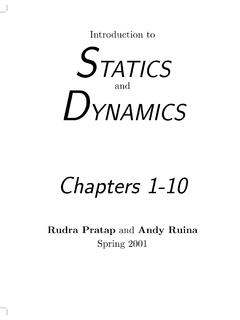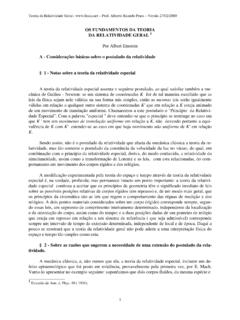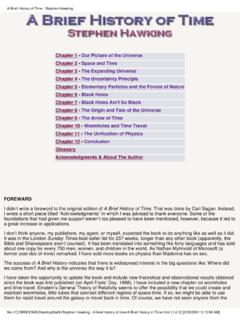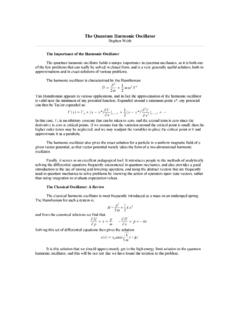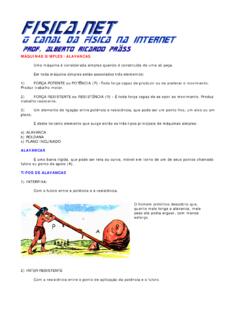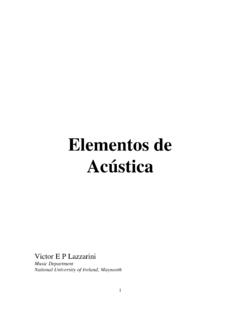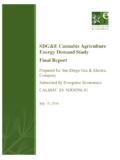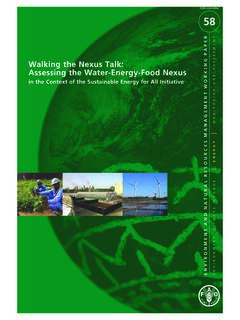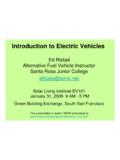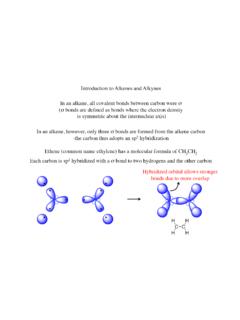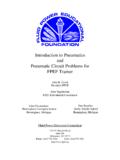Transcription of Introduction to STATICS DYNAMICS Chapters 1-10
1 Introduction toSTATICSandDYNAMICSC hapters 1-10 Rudra PratapandAndy RuinaSpring 2001c Rudra Pratap and Andy Ruina, 1994-2001. All rights reserved. No part ofthis book may be reproduced, stored in a retrieval system, or transmitted, inany form or by any means, electronic, mechanical, photocopying, or otherwise,without prior written permission of the book is a pre-release version of a book in progress for Oxford following are amongst those who have helped with this book as editors,artists, advisors, or critics: Alexa Barnes, Joseph Burns, Jason Cortell, IvanDobrianov, Gabor Domokos, Thu Dong, Gail Fish, John Gibson, Saptarsi Hal-dar, Dave Heimstra, Theresa Howley, Herbert Hui, Michael Marder, Elaina Mc-Cartney, Arthur Ogawa, Kalpana Pratap, Richard Rand, Dane Quinn, PhoebusRosakis, Les Schae er, David Shipman, Jill Startzell, Saskya van Nouhuys, BillZobrist.
2 Mike Coleman worked extensively on the text, wrote many of the ex-amples and homework problems and created many of the gures. David Hohas brought almost all of the artwork to its present state. Some of the home-work problems are modi cations from the Cornell's Theoretical and AppliedMechanics archives and thus are due to T&AM faculty or their libraries in waysthat we do not know how to give proper attribution. Many unlisted friends,colleagues, relatives, students, and anonymous reviewers have also made used to prepare this book includes TeXtures,BLUESKY'simplemen-tation ofLaTeX,Adobe recent text modi cations on January 21, of Mechanics0)The laws of mechanics apply to any collection of material or body.
3 This body could be the overall system of studyor any part of it. In the equations below, the forces and moments are those that show on a free body diagram. Interactingbodies cause equal and opposite forces and moments on each )Linear Momentum Balance (LMB)/Force BalanceEquation of MotionX*FiDP*LThe total force on a body is equalto its rate of change of linearmomentum.(I)Impulse-momentum(integ rating in time)Zt2t1X*Fi dtD1*LNet impulse is equal to the change inmomentum.(Ia)Conservation of momentum(ifP*FiD*0)P*L=*0)1*L=*L2 *L1D*0 When there is no net force the linearmomentum does not change.(Ib) STATICS (ifP*Lis negligible)X*FiD*0If the inertial terms are zero the net force on system is zero.
4 (Ic)II) Angular Momentum Balance (AMB)/Moment BalanceEquation of motionX*MCDPP*HCThe sum of moments is equal to therate of change of angular momentum.(II)Impulse-momentum (angular)(integrating in time)Zt2t1X*MCdtD1*HCThe net angular impulse is equal tothe change in angular momentum.(IIa)Conservation of angular momentum(ifP*MCD*0)P*HCD*0)1*HCD*HC2 *HC1D*0If there is no net moment about pointC then the angular momentum aboutpoint C does not change.(IIb) STATICS (ifP*HCis negligible)X*MCD*0If the inertial terms are zero then thetotal moment on the system is zero.(IIc)III) Power Balance (1st law of thermodynamics)Equation of motionPQCPDPEKCPEPCPEint|{z}PEHeat flow plus mechanical powerinto a system is equal to its changein energy (kinetic + potential +internal).
5 (III)for finite timeZt2t1 PQdtCZt2t1 PdtD1 EThe net energy flow going in is equalto the net change in energy.(IIIa)Conservation of Energy(ifPQDPD0)PED0)1 EDE2 E1D0If no energy flows into a system,then its energy does not change.(IIIb) STATICS (ifPEKis negligible)PQCPDPEPCPEintIf there is no change of kinetic energythen the change of potential andinternal energy is due to mechanicalwork and heat flow.(IIIc)Pure Mechanics(if heat flow and dissipationare negligible)PDPEKCPEPIn a system well modeled as purelymechanical the change of kineticand potential energy is due to mechanicalwork.(IIId)Some Definitions*ror* :g:;*ri *ri=Ois the position of a pointi relative to the origin, O)*v d* :g:;*vi *vi=Ois the velocity of a pointi relative to O, measured in a non-rotatingreference frame)*a d*vdtDd2* :g:;*ai *ai=Ois the acceleration of apointirelative to O, measured in a New-tonian frame)*!
6 Angular(Please also look at the tables inside the back cover.)velocityA measure of rotational velocity of a rigidbody.* P*!Angular accelerationA measure of rotational acceleration of arigid body.*L 8<:Pmi*vidiscreteR*vdmcontinuousLinear momentumA measure of a system s net translationalrate (weighted by mass).Dmtot*vcmP*L 8<:Pmi*aidiscreteR*admcontinuousRate of change of linearmomentumThe aspect of motion that balances the netforce on a *acm*HC 8<:P*ri=C mi*vidiscreteR*r=C *vdmcontinuousAngularmomentumaboutpoint CA measure of the rotational rate of a sys-tem about a point C (weighted by massand distance from C).P*HC 8<:P*ri=C mi*aidiscreteR*r=C *admcontinuousRate of change of angular mo-mentum about point CThe aspect of motion that balances the nettorque on a system about a point 8<:12 Pmiv2idiscrete12Rv2dmcontinuousKinetic energyAscalarmeasure of net system (heat-like terms)Internal energyThe non-kinetic non-potential part of asystem s total P*Fi *viCP*Mi *!
7 IPower of forces and torquesThe mechanical energy flow into a sys-tem. Also,P PW, rate of work.[Icm] 26664 IcmxxIcmxyIcmxzIcmxyIcmyyIcmyzIcmxzIcmyz Icmzz37775 Moment of inertia matrix aboutcmA measure of how mass is distributed ina rigid is mechanics::::::::::::::::::::::::::12 Vectors for notation and vector dot product of two product, moment, and moment about an force of mass and gravity::::::::::::::::::::::623 Free body body diagrams:::::::::::::::::::::::::784 equilibrium of one truss truss analysis: determinacy, rigidity, and and STATICS :::::::::::::::::::::::::::2065 DYNAMICS of and motion in 1 methods in 1 harmonic on vibrations.
8 Oscillations and motions in 1 derivative of a vector: position, velocity and DYNAMICS of a motion and celestial Coupled motions of particles in space::::::::::::::::3126 Constrained straight line constrained motion and and 3-D forces even though the motion is straight::::::::339iiiCONTENTS7 Circular of a particle in planar circular of a particle in circular of a rigid body in planar circular of a rigid body in planar circular moment of inertia: 2-D circular motion DYNAMICS :::::::::4148 Advanced topics in circular description of circular of fixed-axis of inertia matrices [Icm] and [IO] using [Icm] and [IO] balance:::::::::::::::::::::::::::4899 General planar motion of a rigid of planar rigid-body DYNAMICS of 2-D rigid-body planar topics in planar of contacting bodies: rolling and ::::::::::::::::::::::::::::::54210 Kinematics using time-varying base Polar coordinates and path Rotating reference General expressions for velocity and acceleration.
9 560 PrefaceThis is a STATICS and DYNAMICS text for second or third year engineering students withan emphasis on vectors, free body diagrams, the basic momentum balance principles,and the utility of computation. Students often start a course like this thinking ofmechanics reasoning as being vague and complicated. Our aim is to replace thisloose thinking with concrete and simple mechanics problem-solving skills that liveharmoniously with a useful mechanical of freshman calculus is assumed. Although most students have seenvector dot and cross products, vector topics are introduced from scratch in the contextof mechanics. The use of matrices (to tidily set up systems of equations) and ofdifferential equations (for describing motion in DYNAMICS ) are presented to the extentneeded.
10 The set up of equations for computer solutions is presented in a pseudo-language easily translated by the student into one or another computation packagethat the student have aimed here to better unify the subject, in part, by an improved can be subdivided in various ways: staticsvsdynamics, particlesvsrigidbodies, and 1vs2vs3 spatial dimensions. Thus a 12 chapter mechanics table ofcontents could look like thisI. StaticsA. particles1) 1D2) 2D3) 3DB. rigid bodies4) 1D5) 2D6) 3 DII. DynamicsC. particles7) 1D8) 2D9) 3DD. rigid bodies10) 1D11) 2D12) 3 Dcomplexityof objectsnumber ofdimensionshow muchinertia1D2D3 DstaticdynamicparticlerigidbodyHowever, these topics are far from equal in their difficulty or in the number of subtopicsthey contain.
